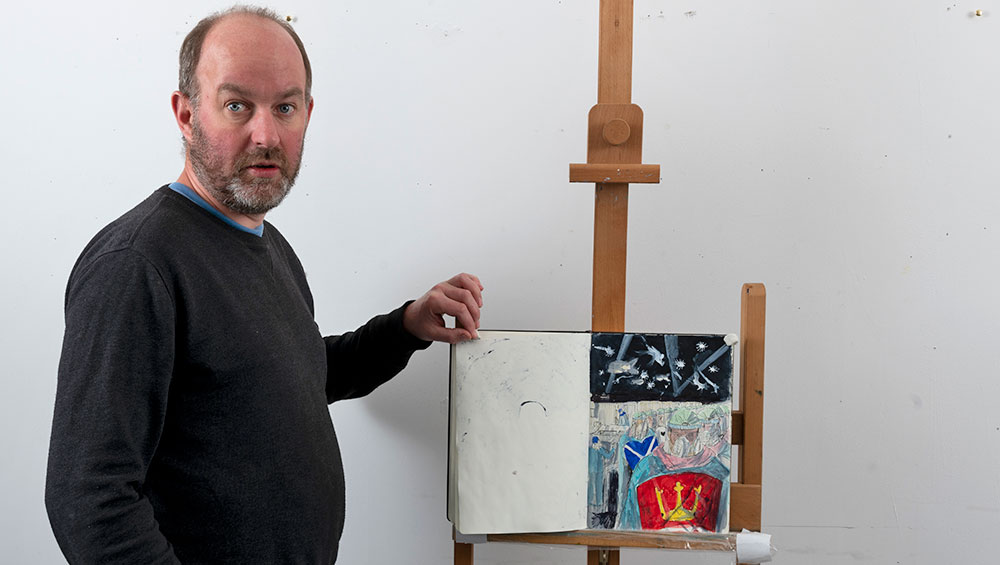
David Downes. Photo: John Milne.
by ANNA McNAY
When it became apparent that something big was approaching – that is, when deaths from Covid-19 started sweeping not just through China but also Italy – landscape artist David Downes saw a once-in-a-lifetime opportunity to document this global pandemic, producing a work a day (or every other day), in the manner of a war artist. Mixing reality with surreality, familiar places with imagined representations of the virus – “Covids”, as Downes calls them – he has a growing series of pen, ink and acrylic drawings. Once there is more freedom of movement and he can return to his studio, Downes hopes to work some of these up to larger scale on canvas. He also has plans for an exhibition.
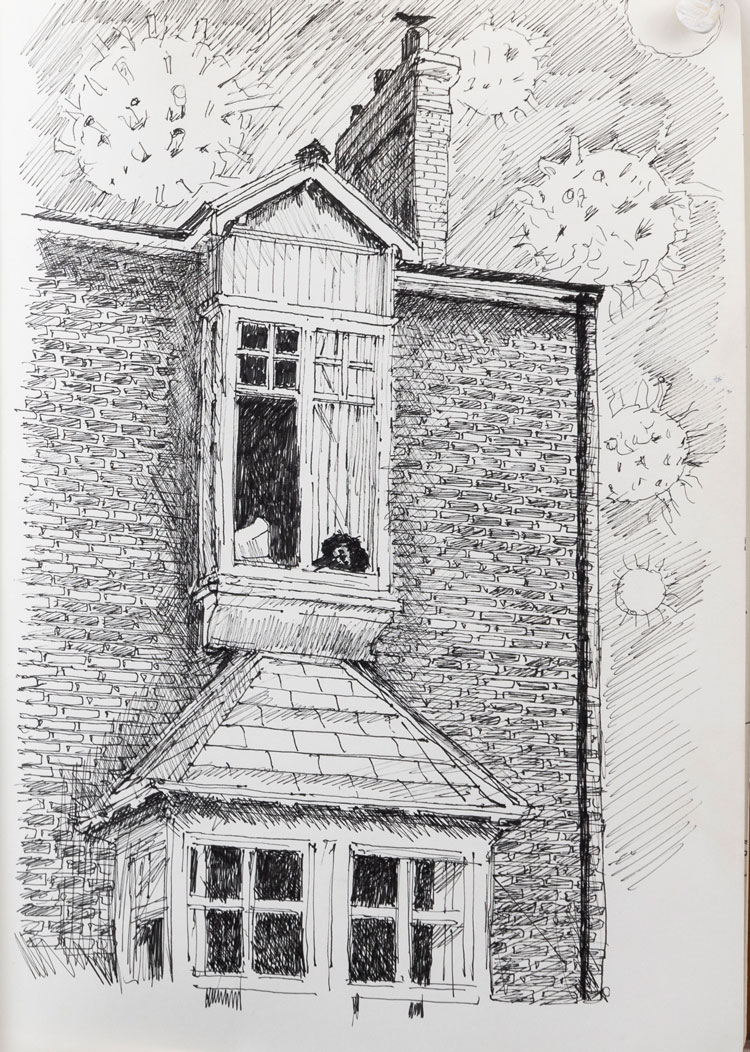
David Downes. Lockdown, 2020. Pen, ink and acrylic on paper.
Downes, who was born in Sutton Coldfield, Birmingham, in 1971, completed an MA in communication design at the Royal College of Art, London, in 1996. His first major contract, in 1999, was a commission from the BBC to record the corporation’s most important architecture at the turn of the century. He has since had numerous other prestigious commissions, including painting the Thames Diamond Jubilee Pageant from the roof of the Savoy Hotel in 2012, and, last year, creating a giant mural for the launch of a new ITV period drama, depicting the fictional coastal town of Sanditon, based on Jane Austen’s final, unfinished novel.
Having been diagnosed with high-functioning autism at the age of 32, Downes is an active supporter of the National Autistic Society and has been a vice president since 2012.
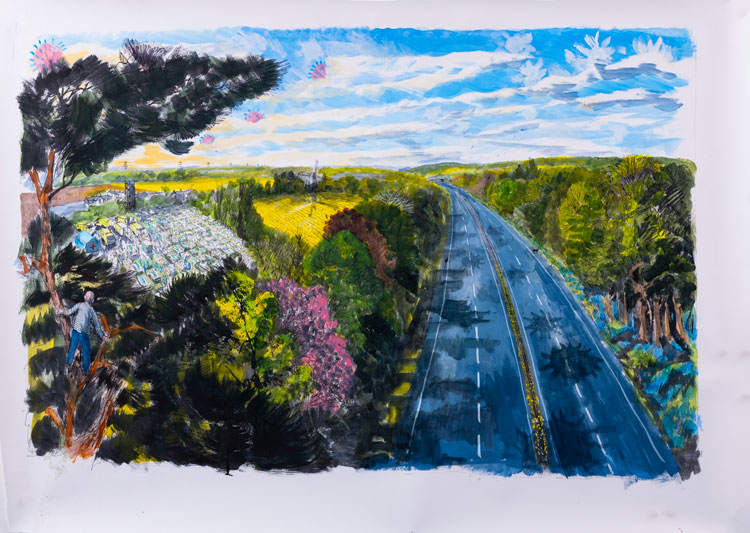
David Downes. Long Road Ahead, 2020. Pen, ink and acrylic on paper.
As Studio International calls Downes, one morning during lockdown, he is just about to start work on another large drawing, working from a spare room in the house he shares with his girlfriend and their dog, Winston, in Manningtree, Essex.
Anna McNay: Thank you for making time to speak to me. I don’t want to hold you up from your drawing.
David Downes: No, not at all. I enjoy talking about what I’m doing at the moment. It’s a bit of an unbelievable time, isn’t it?
AMc: It is slightly, yes.
DD: It’s scary. Scary, and kind of weird.
AMc: I think it is the not knowing when it is all going to end, and how it is going to end, that makes it worse.
DD: There’s a lot of uncertainty. We will have to make a lot of changes to how we live. I was just talking to my neighbour. She was saying how the environment and air quality have massively improved since lockdown.
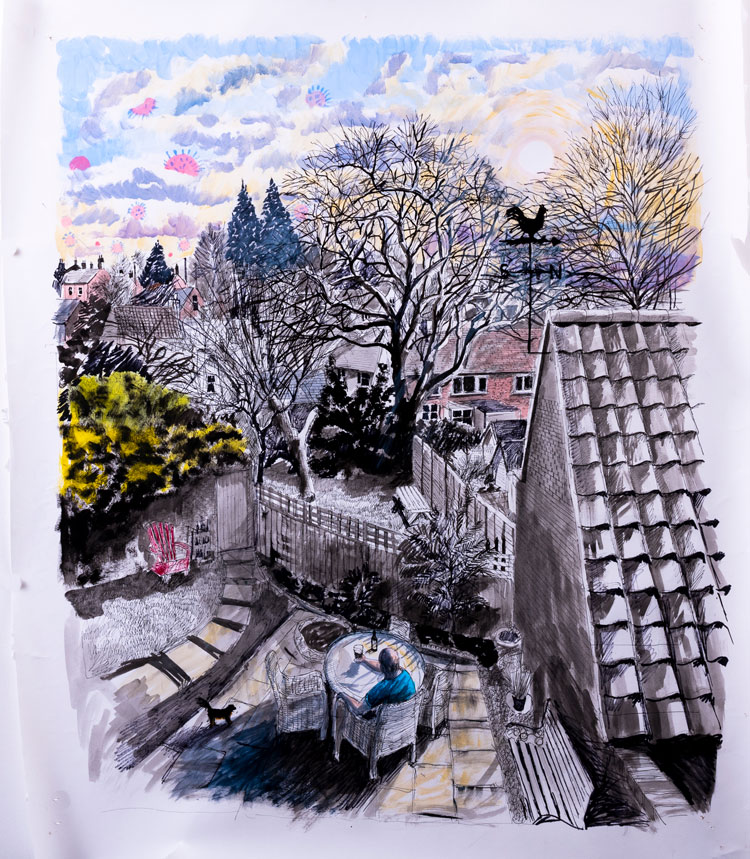
David Downes. Self Isolation and Contemplating Life in a Changed World, 2020. Pen, ink and acrylic on paper.
AMc: Yes, absolutely. But then I have been reading some really scary stuff, where they are saying that it is going to be even worse afterwards, because the governments are going to put all their effort into recouping money and businesses, and therefore they are going to be using lots more fossil fuels …
DD: It’s a play-off between our physical health and making sure people don’t die, and the wider economic world. When I’m thinking about doing my artwork, and painting about it, it’s just such a strange time to be alive.
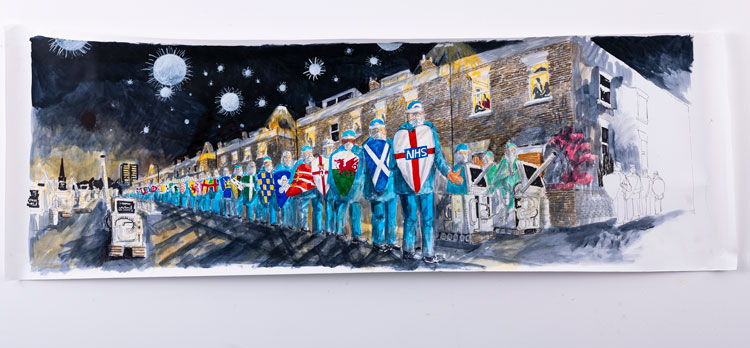
David Downes. The Front Line, 2020. Pen, ink and acrylic on paper.
AMc: It is certainly material to work with. You have been producing some amazing responses. Have you been doing a work a day, as the press statement says?
DD: I try to. I know that’s what my agent wrote in the proposals, so, I try to, but my girlfriend works from home as well, and we’ve got the dog. I take weekends off as time for gardening and getting stuff done in the house. But, normally, during the week, I can get one done a day, or one every other day. But, obviously, I’ve got to get the idea to generate the sketch.
AMc: Of course …
DD: So, maybe one every other day.
AMc: When you started working like this, you probably didn’t have a clue how long lockdown was going to go on for …
DD: Well, exactly. I mean, one a day would be ideal, but obviously there is so much stuff, like vacuuming and general house stuff, that you have to do. So, one every other day. Normally, also, with Facebook and Instagram, if I put a picture up, it’s good to have it on there for a couple of days so I can see what the response is before putting another one up – rather than bombarding people with picture after picture. Some get loads of responses and others get fewer. It depends on the subject.
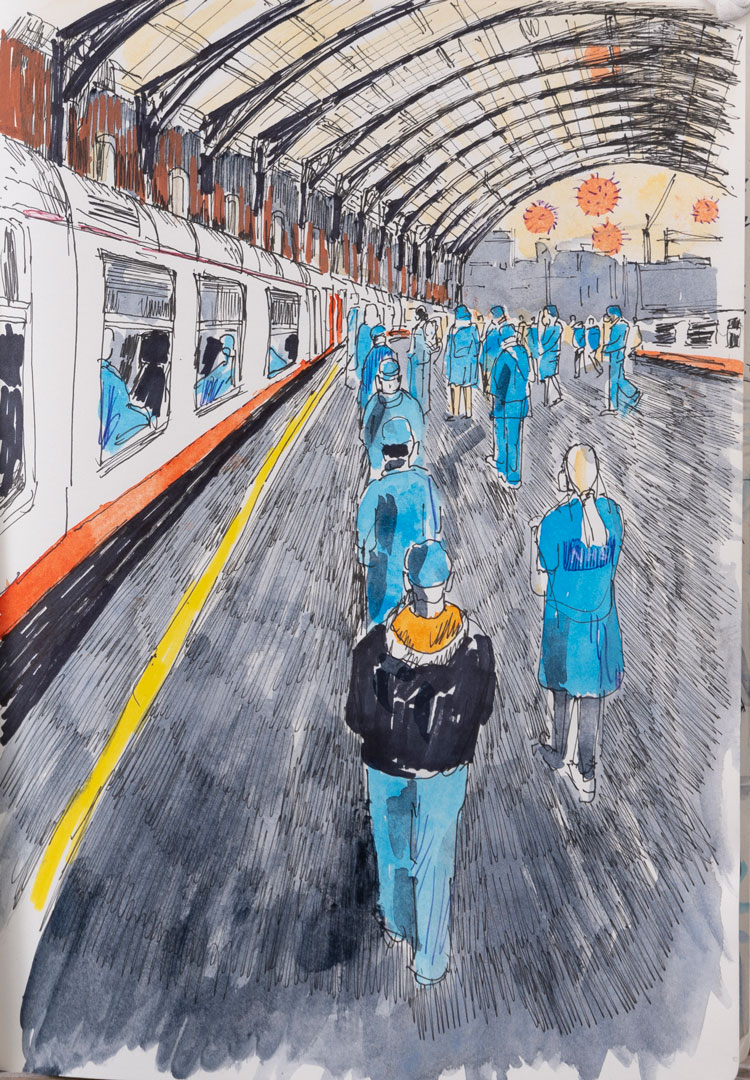
David Downes. Battle Stations, 2020. Pen, ink and acrylic on paper.
AMc: Have you figured out what it is that is particularly getting people to respond? It seems like months and months ago that lockdown first started. I suppose your first responses were the pictures of the overcrowded tube trains?
DD: It’s a nightmare, isn’t it? We now live in Manningtree, in the Essex countryside, so we haven’t had that issue of working and living in London, but I just tried to describe the overcrowded trains and platforms with the Covid-19 virus hovering all around them. The invisible enemy. More recently, my pictures have moved on to depict the NHS key workers. They’re our warriors, aren’t they, on the frontline? They’re going into war with their shields and PPE. Because it is like a war, in a way.
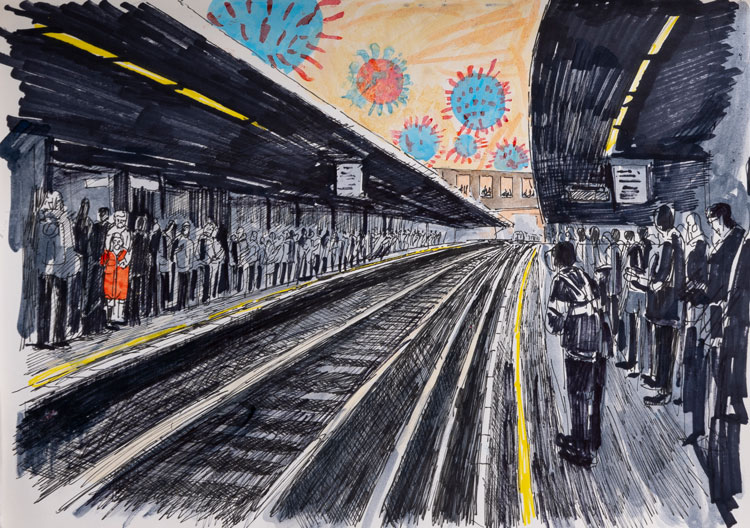
David Downes. Stand Behind the Two Meter Line, 2020. Pen, ink and acrylic on paper.
AMc: Yes, and I was thinking how your pictures are documenting these times in much the same way as the works of the war artists documented those times.
DD: Yes.
AMc: Do you see your role like that?
DD: Yes, I think so. When I was at Royal College in the mid-90s, I did quite a lot more imaginary work, such as Dis-ordered Development, which was about my struggle with autism, or Asperger’s, as it was then. Being autistic, but not knowing I was. Then I moved away and did more conventional artwork. I lived in the United States for three years, at Newport Beach. I did a lot of paintings in California, which opened my mind a little bit to doing different types of work. And then this happened. We could see the monster coming over the hill in January. Something was not right in China. Then, once lockdown was imposed, I thought, well, this is an opportunity to go back to doing more imaginary work. It seemed like an opportunity. I also felt incredibly inspired. Through the adversity, I thought this is something I’ve got to get down on paper. I think the first picture I did was of the beds …
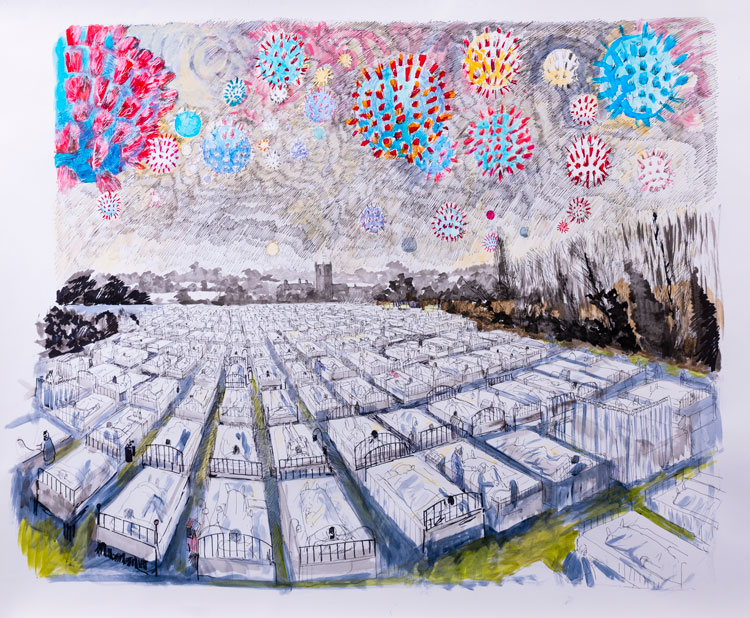
David Downes. Where Once There Were Fields, 2020. Pen, ink and acrylic on paper.
AMc: Where Once There Were Fields?
DD: Yes, and there is one I was doing at the same time, Will the World Ever Be the Same Again, depicting a local footpath, where we walk every day, with lots of beautiful scenery and woodland. I wanted to do that and put the Covids in the sky. There’s this powerful, imminent threat. Also, it’s facing towards London, where all of the Covids were coming from. The white figure is me. That was the first one, I think.
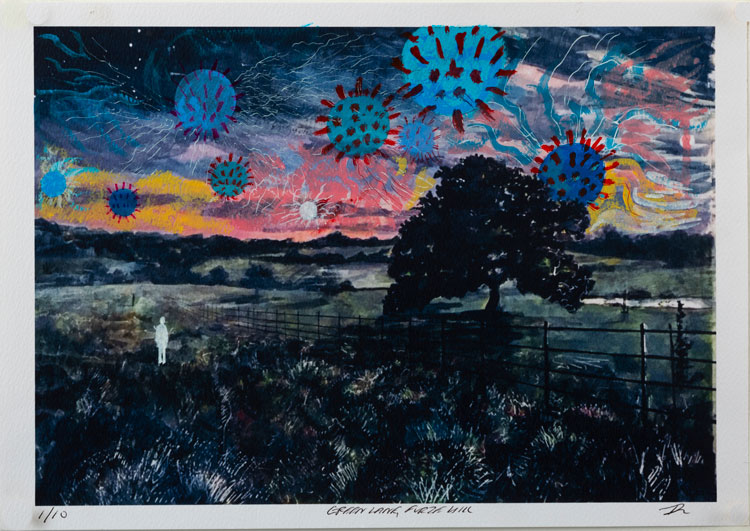
David Downes. Will the World Ever Be the Same Again, 2020. Pen, ink and acrylic on paper.
And then, at the same time, I had the idea of a field hospital, and I thought, well, I remember seeing lots of pictures and films about the Spanish flu at the end of the first world war, which killed more people than the war did, and so I started that one, too. I know it would never be like that now, with an outdoor field hospital. With the Covids in the sky, it’s almost like it’s a war of the worlds, where they’re there, but they’re not there, and I think that shocked a few people. It got quite a positive response from a lot of people who didn’t know that I could do work like that. And so, I thought, right, I’ll turn this into a project. I suppose that was eight weeks ago now.
AMc: That’s a couple of weeks before the official lockdown, then.
DD: It does seem like a lifetime ago. And there were still things like the Cheltenham races taking place. That was crazy. Looking back on it, it’s totally mad that we did that. Anyhow, that’s how it began. I’ve moved on a bit since. I guess it is like a war, and I’ve always thought of myself as a war artist. A lot of my work is influenced by war artists such as Paul Nash. This is the nearest thing in our generation to that experience.
AMc: Absolutely. Hopefully.
DD: I was thinking about it last night. I get a lot of my ideas at the weekend. I sit in my garden and have a couple of beers, and often that’s where I get my ideas. I just sit there and think about stuff and listen to music, and then I’ll get the sketchbook out and do some drawings. It’s strange living through this global pandemic without really knowing anyone who has been ill with the virus. There are people in London I know, and my friend who lives in Barnstable, her aunt has got it quite badly, but so many thousands of people have died, and I don’t know any of them directly. At the same time, the effect is so powerful because you turn on the television and it’s all you see, you’re social distancing at supermarkets, everyone’s worried about being too close to other people, and then you’ve got the economic impact as well. There’s a lot of worry about how it’s going to affect the economy when we come out of lockdown. There are so many fears and emotions all at the same time.
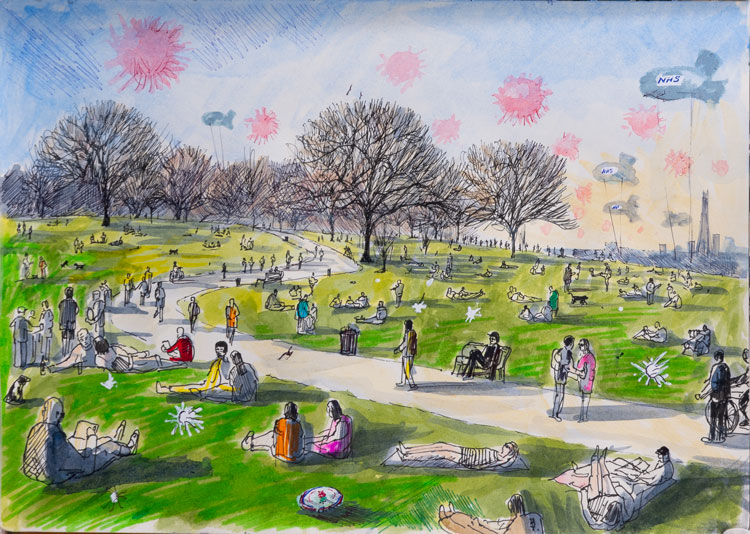
David Downes. The Enemy's Useful Idiots, 2020. Pen, ink and acrylic on paper.
AMc: But yet, as you say, it is almost surreal, because if it has not affected anyone whom you know directly, and you don’t see it around where you live It is going on, and you know that it is going on, but it is quite hard to get your head around that.
DD: Totally. We’ve got a good sense of community here in Manningtree. London is a lot more problematic, a lot more difficult. But, up here, we’ve got our social WhatsApp groups. They drive you mad, though. It’s like old mates in a pub and people messaging one another with how many beers they’re drinking. I haven’t seen half the people I used to see though. I’ve just been to the hardware store and saw my friend, Sam, who lives in the town, and it’s weird seeing someone, because otherwise I’ve just been chatting with my girlfriend every day – and our dog. I think people have been really compliant, overall, up here. I suppose because everybody knows one another, they are all being really polite in the supermarket and giving one another space.
AMc: That’s good.
DD: In London, my mates have been saying that it has been a bit tricky.
AMc: Well, it’s harder, isn’t it, because it’s just so overcrowded there.
DD: Yes. And that’s where a lot of the problems started. I had this idea for another picture with an NHS balloon. It’s like a barrage balloon from the second world war – you had these in London to try and stop the Luftwaffe from low-level bombing. I thought I’d use that idea and put “NHS” on the side of the balloon, so they’re like blimps. My last one, Lockdown Blues, was me looking up, in a woodland, surrounded by trees like a kaleidoscope, and thinking: “Christ, when are we going to get out of this?” We’re locked into lockdown. Some people don’t want to go back to work. People are worried.
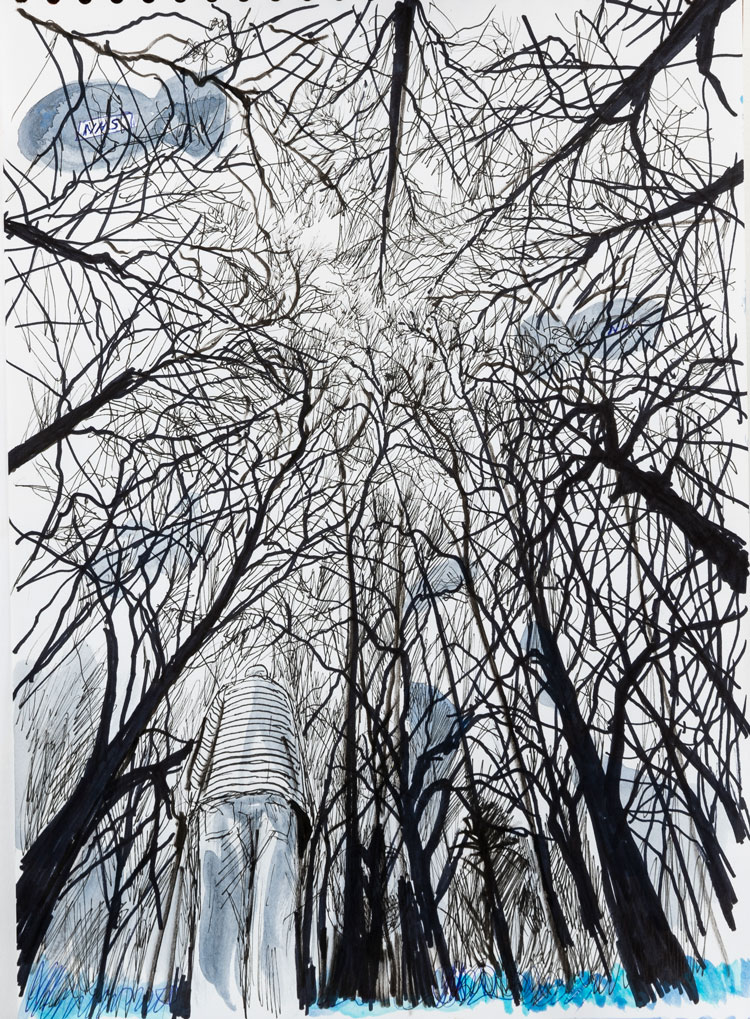
David Downes. Lockdown Blues, 2020. Pen, ink and acrylic on paper.
AMc: You have said that when you have your ideas, you make quick drawings in your sketchbook. What happens next? Do you then select which ones you want to work up to a larger scale?
DD: Initially, when I get my ideas, I immediately put notes into my phone, because I often get them at night or while watching television. Today, for example, I’ve got five or six ideas. I’ll start drawing them out in a sketchbook and maybe doing more detailed drawings. Then I photograph those, put them up on Instagram and Facebook, send them to my agent, and then think about doing even bigger works from them. My hope is to try and get an exhibition once this is all over.
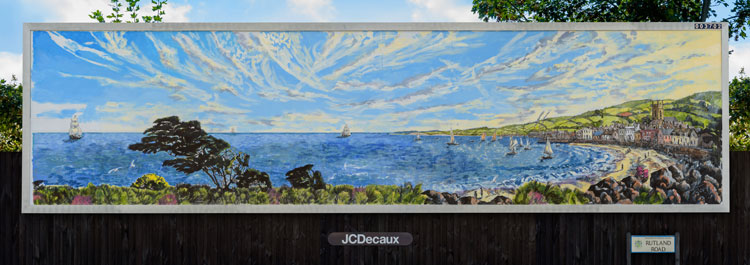
David Downes. Sanditon mural, 2019. Mixed media. Photo: Dan Tsantilis.
AMc: What materials do you work with? In the video showing you making the mural of Sanditon for the launch of the 2019, Jane Austen, ITV period drama, you seem to be working with paint and brushes, but also with marker pens for the finer detail.
DD: Yes, I use quite a lot of pen and ink, acrylic and marker pens. Mixed media, basically, as much as I can. And I work a lot on canvas. But it hasn’t been easy working on canvas from home. I’ve been doing a lot of work on paper – but big paper. I know in my head how they’re going to look in the exhibition, so hopefully I’ll go to the studio, when I can, and get some canvases and start on them. In the studio, I’ve got high ceilings, you see. I can do really big work, but at home it’s not as easy.
AMc: Are you not able to get to your studio at the moment?
DD: I’m going tomorrow, but that’s the first time in two months. I need to get hi-res images taken of my new work. The photographer will come and we’ll keep two metres apart.
AMc: Can you tell me about your typical day at the moment in lockdown? Do you have a fixed routine for when you get up and how long you work for, or is it more a case of playing it by ear?
DD: It sounds terrible, but I get up quite late sometimes. My girlfriend gets up quite early. I’ll start work at about 11.30, 12, but then I have a very productive period between 12 and 3pm, and then we’ll go for a walk. Basically, I’ll work really intensely and quite fast, and some days I do get more done in the mornings, late mornings, but every day I have a fixed routine. I go for these ridiculously long runs as well. That’s just to keep fit and to keep in the sunshine. They’re saying if you do catch the virus, if you’re fit and you’ve got a lot of vitamin D … I don’t know if it’s fake news, but there are so many theories about how to build up your immune system and so forth.
AMc: The imagery that you’re working with is a mixture of real scenes that you know and then improvised and embellished imaginary features.
DD: Yes. I think this is the first time I’ve managed to make the crossover in my work for quite a long time. I’ve started to get more symbolism into my work, but not in a cliched way, just a little bit more blending. I very rarely work from observation. I look at stuff, but I work by and large in my imagination. I visualise. I might take a photograph of something that’s interesting. There’s a massive tree around here called Old Nobbly. It’s about 850 years old. And there’s currently a Save the NHS label stuck on its trunk. I had the idea of doing something with this ancient tree, and the history of it. So, I look at stuff and have an idea, but then I work more comfortably from my imagination.
AMc: And, at the moment, you’re imagining quite a lot of surreal stuff …
DD: Yes. So, I’ll do a picture of the Essex Way and suddenly there’ll be an NHS blimp, or there’ll just be Covids floating through the sky. Then I add myself in, which is a bit like with Dis-ordered Development – me in the work, showing how I see the world.
AMc: Tell me about the Covids. Where did the idea for representing the virus in this way come from? They’re really colourful …
DD: Almost beautiful.
AMc: Yes.
DD: It’s the way that we interpret what they look like under the microscope. But I thought they’re a beautiful enemy. They’re beautiful to paint, but they’re lethal, and they’re like floating ships. And then I saw them on the TV, when they started getting more deaths in Italy, and I thought: “Holy shit.” I thought this is an opportunity for me to develop as an artist, get myself out there, because all artists are slightly egocentric in that sense. I’ve got so much time with the lockdown. There are no exhibitions and there’s no structure, so I had to create my own structure. So, that was it. That’s the Covids. I’ve used artistic licence with them as well to make sure that they look like Covids and not spaceships. Almost like a sort of HG Wells invention, but they’re in the sky, like aliens, and we don’t really understand them. That’s the thing. We’ve had pandemics before, like the bubonic plague, and we handled it badly then. We’re handling it no better now. There are some countries where there are hardly any cases, though. My brother lives in New Zealand with his family. Jacinda Ardern is brilliant, she’s such a progressive politician. Eventually, we’ll get on top of it, and the death toll will plateau, and there’ll be the next stage. I’ve got this idea of NHS workers beating the Covids somehow. I’m trying to think of ideas. Also, a crashed Covid somewhere in a hedgerow.
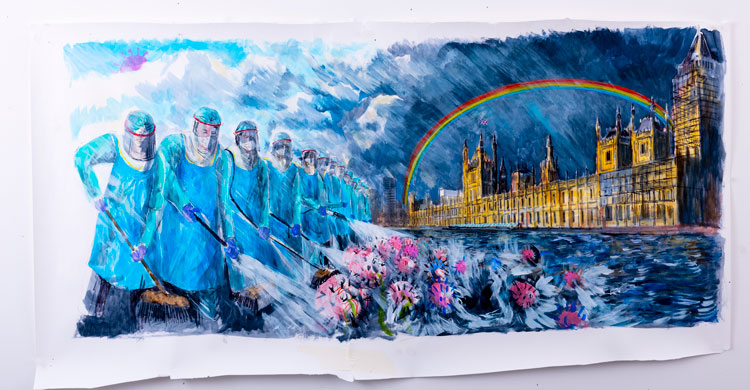
David Downes. In the Final Analysis, 2020. Pen, ink and acrylic on paper.
AMc: Do you envisage this as a complete series, ultimately?
DD: Yes. And I’ll work up some of the smaller pictures into bigger pictures in the studio and then work out what we’re going to do. The idea would be to get more and more exposure and, as I’ve said, have an exhibition, which would be great.
AMc: Are the works for sale now, then, or are you keeping them for the time being, until after they have been exhibited?
DD: They’re for sale, but, if people are interested, we tell them we’re going to have an exhibition and so we’d like to hold on to them.
AMc: Can I ask a couple of questions beyond this project, about your wider career? You have had some pretty impressive commissions in your time. I have mentioned the Jane Austen one, but your first major contract was to record the BBC’s most important architecture at the turn of the century, later becoming artist-in-residence to BBC Heritage, and then you had a commission from the Savoy Hotel in 2012 to paint the Thames Diamond Jubilee Pageant from the hotel’s roof. What have been some of the highlights for you?
DD: I was thinking about this last night, actually. From a creative point of view, and as an artist, this is probably one of the highlights. But, certainly, a real high was the Sanditon commission last year. I think having had these commissions has given me confidence. I’ve got a bit more of a profile now, so when I started to get ideas for doing artwork about Covid-19, I felt I had the confidence and the ability.
Another high point was living in the United States. I was totally unknown in Orange County. It was a challenge living there and having to almost start again as an artist, after having lived in Stoke Newington [in north London], where I was quite well known.
Getting into the Royal College all those years ago was a highlight as well.
But Sanditon was great to work on, something that big.
AMc: How did you get that commission?
DD: It was through my agent. I had an exhibition at the Hospital Club in London. Quite a lot of media people go there. The exhibition looked good. A lot of it was my American work. The exhibition was quite quiet, but somebody went in and made a note of it. They contacted my agent, and we went from there. It’s not serendipitous. Things happen. Suddenly you get a spin-off from something, or another opportunity.
AMc: What was it that took you to the United States? Was that work-related?
DD: It was down to my girlfriend’s job. She works for a media company and got transferred. We were out there for three years. It was fascinating. I know a little bit about the New York art scene. I’m a big fan of the abstract expressionists, which is maybe surprising, because my work is not at all abstract. I think Mark Rothko, Robert Motherwell and Willem de Kooning are great American artists, great thinkers and very innovative. But moving to Orange County, the art scene there seems to be just emerging. I had an agent representing me while I was in America, and I was doing pictures that were quite different from what was common on the art scene there. It’s all very much plein air: you sit in front of something and it has to be a certain size, which is normally very small. The plein air art movement really wanted me to join, but I struggled because I wanted to do large-scale work. I was doing these big pictures of palm trees, and I thought: “I’m on to something here, I need to keep pushing.” But no one would buy them. I did sell privately in the end. I did all right. People got to know me. I was using more black, making quite silhouetty black palm trees, and using different colours and pen and ink. It was very conventional there in Orange County. But Los Angeles was completely different. Los Angeles is very exciting, very liberal, very hipster.
AMc: I have one final question, before I let you get on with your work. You alluded earlier to your autism.
DD: Yes. I was diagnosed late in life with high-functioning autism in 2002. In those days, there was still a bit more of a stigma. It was almost like, “David Downes, you’re an artist in your own right, you don’t want to be talking about autism, blah blah”, but I think that since then it’s completely changed, people’s perception and understanding of mental health and various neurological conditions and disorders has improved. Americans still call them diseases, though, and it’s not a disease. It’s just a different way of thinking.
I think the autism does assist my work with the detail and the capacity to visualise and also to get obsessive about stuff. But a lot of the work I did at the Royal College, before I got my diagnosis, was about my struggle with autism, being different. I often struggled to fit in. I still had groups of friends, though, and, in hindsight, I had a really good time. I went to the Royal College bar and socialised with all the painters and sculptors, some of whom are now quite famous. I had a sort of developmental autism, so I was still growing and learning, and I think a lot of my work has been about that struggle socially, and about anxiety-related stuff, and now, suddenly, it’s like, well, the whole world is struggling, so, I can transcend that, my struggle, to look at the bigger picture and document it.
If you’re higher functioning, then obviously it can be a pain in the arse for people who are close to you, because you go on and on about stuff. During lockdown, especially, because there’s a lack of certainty. But I’ve learned to live with it, and my girlfriend understands me. She doesn’t have to ever say anything because I know she understands. My mum does as well, but it was quite a struggle when I was younger. And when I left the Royal College it was a struggle because I didn’t know whether I was an illustrator or a fine artist. I was much more of a fine artist, but tended to do work that was quite illustrative. But things have really changed since then. I think they’ve got a lot better, in the sense that you’ve got social media now. I hate it in a lot of ways, but for putting paintings out there, you’ve got an instant gallery, whereas in the olden days you would have to get them photographed, then you had to get a portfolio, then you had to approach a gallery, etc, etc. Now it’s really different. Putting artwork up on social media has been nothing but positive for me. Some of my artwork is a little bit gloomy and a little bit scary, but people are asking to buy prints of the ones with the NHS with the shields. That was quite a complicated picture to do and I somehow managed to pull it off. I’m going to be doing a cherry blossom one with an NHS blimp. That’s what I think I’m going to do today, in fact.